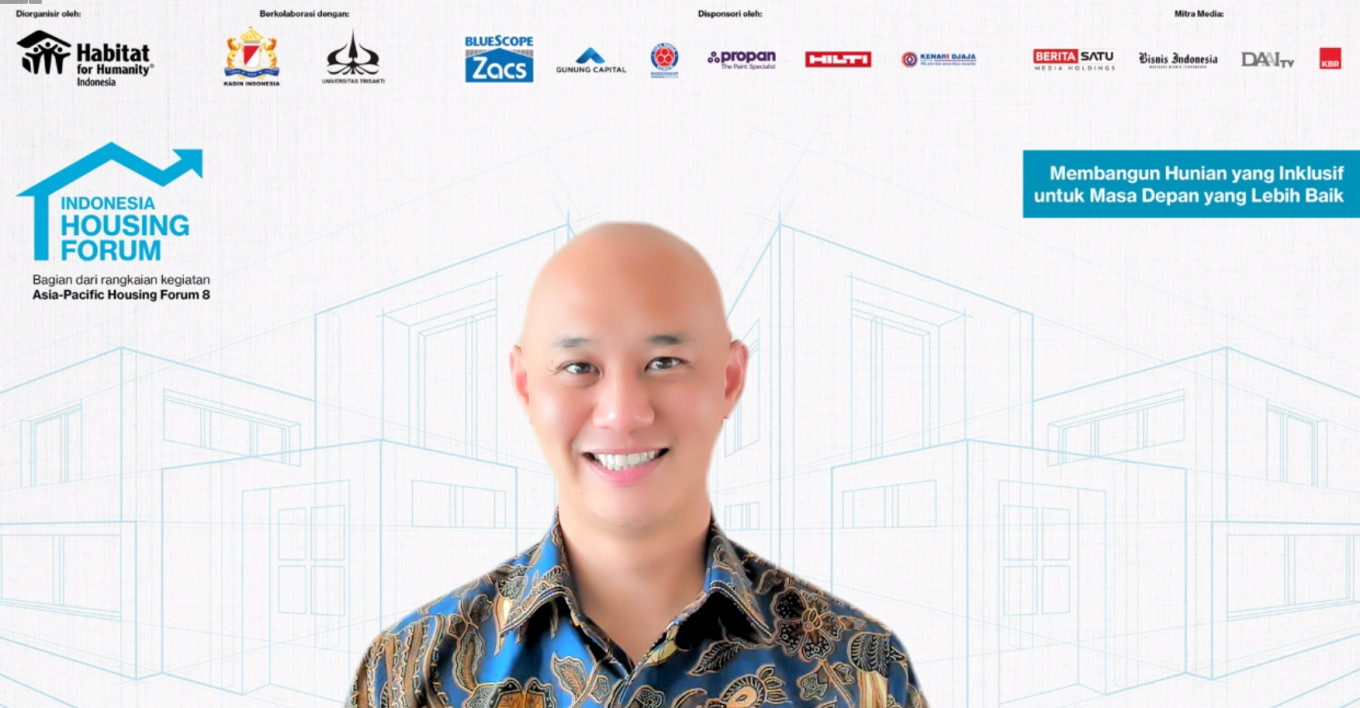Popular Reads
Top Results
Can't find what you're looking for?
View all search resultsPopular Reads
Top Results
Can't find what you're looking for?
View all search resultsGreen housing takes centerstage at crossroads of sustainability and urbanization
Experts have revealed that the rise in urban populations across Asia has led to shortages of affordable housing in numerous cities.
Change text size
Gift Premium Articles
to Anyone
E
xperts have revealed that the rise in urban populations across Asia has led to shortages of affordable housing in numerous cities. The issue was spotlighted at the Indonesia Housing Forum earlier this month, as a part of the Eighth Asia Pacific Housing Forum for a national level discussion with stakeholders, property developers and observers of residential issues.
The panels sought to identify solutions to uplift and inspire economic growth and housing affordability for a progressive Indonesia, while also aiming to promote green housing and the overall real estate sector in the country.
A company that has stood out as the solution in housing affordability and sustainable development is Gunung Capital, a private investment management company based in Indonesia whose managing partner, Kelvin Fu spoke at the forum.
The company has championed the energy transition by embracing clean technologies and sustainable solutions in green housing. Focusing on values guided by environmental, social and governance (ESG) agendas, Gunung Capital has already invested in the development of green steel and green cement along with other low-carbon building materials.
“As a private investment management company, we are focused on impact investments guided by ESG frameworks with a vision to help the world better protect the environment,” Fu said. He added, “we think it’s important for asset managers to lead on commitments to encourage the adoption of decarbonization technology and related innovation, establishing carbon credits as a recognized emerging asset class and ultimately funneling more capital into sustainable enterprises.”
Green houses are high-performance buildings designed, built, operated and decommissioned in a resource efficient manner that minimize the overall impact on the environment, ecology, natural resources and health. Green houses are built using green steel and green cement, as well as technological innovations to reduce energy usage and carbon footprints.
It is estimated that green steel production leads to savings of 36 tons of CO2 emissions per ton of steel, while the manufacturing of green cement (slag cement) leads to savings of around 20 tons of CO2 per ton of cement.
The carbon emissions from buildings and related sectors constituted more than one third, or 38 percent, of global energy-related emissions in 2019. The amount will only continue to rise with the boom of infrastructure that is expected with rapid urbanization in Indonesia. It is estimated that 60 percent of the area that will house 70 percent of the global population by 2050 remains yet to be developed.
Fu, on behalf of Gunung Capital, said that the company aimed to invest in voluntary carbon markets with the intent of delivering high rates of returns to investors, while supporting the transition to lower carbon emissions in Indonesia.
The construction of sustainable and green housing will be a necessary measure to lessen direct and indirect carbon emissions from the industry by 4 and 7 percent, respectively, on an annual basis between now and 2030. This is in line with the rules set forth by Intergovernmental Panel on Climate Change (IPCC) that Indonesia has agreed to.
Other than the environmental benefits of green housing, cost advantages are rapidly becoming apparent to builders, who pass on cost savings to consumers in a positive cycle of affordability that reduces electricity bills and water consumption while offering higher asset appreciation. Green housing controls water conservation measures by rainwater harvesting, as well as using sustainable materials like low carbon and ethical raw materials and renewable power to lower dependency on fossil fuels.
The potential to build additional revenue streams for project developers through carbon credits, which are tradable certificates earned through the removal of greenhouse gases and carbon emissions from their operations, improves the consistency of returns on investment. Green houses are particularly eligible for carbon credits based on solar or renewable power installations, waste management and the aforementioned water conservation.
Growing awareness of the monetary savings from green buildings as well as government policies on emission cuts that offer support and incentives, such as tax breaks, continue to bolster green housing growth. As exemplified by Indonesia’s Green Sukuk sovereign bonds,
issued to raise approximately US$14.1 billion for investments in domestic green buildings.
The phenomenon has gained more popularity, with the International Finance Corporation and Green Building Council of Indonesia’s collaborating on a project aimed at certifying at least 20 percent of new construction projects as green.
The industrial and housing sectors contributed to approximately 41 percent of the country’s GDP in 2019, and it will only increase with the development of the new capital city in East Kalimantan.
At an estimated cost of $33 billion, the new capital is expected to drive employment while housing 1.5 million people with a focus on smart and sustainable housing models, where a 75 percent green space allocation will be maintained for environmental balance.











